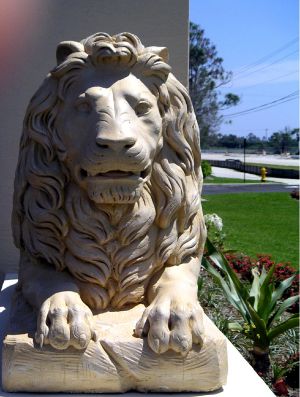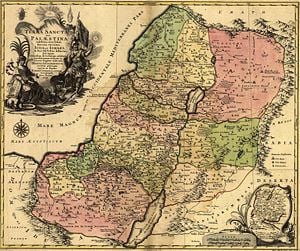Difference between revisions of "Tribe of Judah" - New World Encyclopedia
m |
({{Contracted}}) |
||
| Line 1: | Line 1: | ||
| − | {{claimed}} | + | {{claimed}}{{Contracted}} |
:''This article is about the Hebrew tribe. For the musical band see: [[Tribe of Judah (band)]]'' | :''This article is about the Hebrew tribe. For the musical band see: [[Tribe of Judah (band)]]'' | ||
Revision as of 14:50, 19 February 2007
- This article is about the Hebrew tribe. For the musical band see: Tribe of Judah (band)
Template:Tribes of Israel The Tribe of Judah (Hebrew: Template:HbryodְהTemplate:HbrshuruqדTemplate:Hbrqamazה, "Praise"; Standard Hebrew Yəhuda, Tiberian Hebrew Yəhûḏāh) is one of the Hebrew tribes, founded by Judah, son of Jacob(Israel).
Together with the Tribe of Benjamin and the Tribe of Levy, descendants of Judah eventually formed the southern Kingdom of Judah in the ancient Land of Israel, when the Kingdom of Israel was divided. These two tribes were thus not carried into captivity with the ten tribes of the northern Kingdom of Israel when it fell. This started the tradition (some say of the Ten Lost Tribes of Israel.
As the Tribe of Benjamin was always very much the minor partner, in time the tribe of Judah became identified with the entire Israelite nation, and even the entire Hebrew nation, and gave their name to the Jews, see Jews as Israelites.
In the Bible
Judah and his three surviving sons went down with Jacob into Ancient Egypt (Gen. 46:12; Ex. 1:2). At the time of the Exodus, when we meet with the family of Judah again, they have increased to the number of 74,000 males (Num. 1:26, 27). Its number increased in the wilderness (26:22). Caleb, the son of Jephunneh, represented the tribe as one of the spies (13:6; 34:19). This tribe marched at the van on the east of the Tabernacle (Num. 2:3-9; 10:14), its standard, as is supposed, being a lion's whelp. Under Caleb, during the wars of conquest, they conquered that portion of the country which was afterwards assigned to them as their inheritance. This was the only case in which any tribe had its inheritance thus determined (Josh. 14:6-15; 15:13-19).
The inheritance of the tribe of Judah was at first fully one-third of the whole country west of the Jordan River, in all about 2,300 square miles (Josh. 15). But there was a second distribution, when Simeon received an allotment, about 1,000 square miles, out of the portion of Judah (Josh. 19:9). That which remained to Judah was still very large in proportion to the inheritance of the other tribes. The boundaries of the territory are described in Josh. 15:20-63.
This territory given to Judah was divided into four sections.
- The south (Heb. negeb), the undulating pasture-ground between the hills and the desert to the south (Josh. 15:21.) This extent of pasture-land became famous as the favourite camping-ground of the old patriarchs.
- The "valley" (15:33) or lowland (Heb. shephelah), a broad strip lying between the central highlands and the Mediterranean. This tract was the garden as well as the granary of the tribe.
- The "hill-country," or the mountains of Judah, an elevated plateau stretching from below Hebron northward to Jerusalem. "The towns and villages were generally perched on the tops of hills or on rocky slopes. The resources of the soil were great. The country was rich in corn, wine, oil, and fruit; and the daring shepherds were able to lead their flocks far out over the neighbouring plains and through the mountains." The number of towns in this district was thirty eight (Josh. 15:48-60).
- The "wilderness," the sunken district next to the Dead Sea (Josh. 15:61), "averaging 10 miles in breadth, a wild, barren, uninhabitable region, fit only to afford scanty pasturage for sheep and goats, and a secure home for leopards, bears, wild goats, and outlaws" (1 Sam. 17:34; 22:1; Gospel of Mark 1:13). It was divided into the "wilderness of En Gedi" (1 Sam. 24:1), the "wilderness of Judah" (Judg. 1:16; Matthew 3:1), between the Hebron mountain range and the Dead Sea, and the "wilderness of Maon" (1 Sam. 23:24). It contained only six cities.
Nine of the cities of Judah were assigned to the priests (Josh. 21:9-19).
Modern descendants
Most Jews are descended from this tribe.[1][2][3][4]
According to Judeo-Christian belief, The Messiah came out or will come out of the tribe of Judah. "The staff shall not depart from Judah, nor the sceptre from between his feet..." (Genesis 49:10)
Notable members
- Judah, Biblical eponymous ancestor of the tribe
- Perez, his son.
- Nachshon, a chieftain from the time of the Exodus.
- Caleb, military leader from the time of the Exodus, and his brother Kenaz.
- Othniel, leader from the period of the shoftim and son of Kenaz.
- Possibly the judge Ibzan (but see that article for controversy).
- Boaz, Obed, and Jesse, the great-grandfather, grandfather and father, respectively, of King David.
- David, king of Israel and founder of the Davidic line.
- The Kings of Judah who were descended from David (but not the later Hasmonean kings of Judea, who were Levites of the priestly caste.
- The prophets Amos, Habakkuk, Isaiah, Jeremiah, Joel, Micah, Obadiah, Zechariah, and Zephaniah.
- Shealtiel and Zerubabel, figures of the Babylonian Exile.
- Hachaliah
- Nechemiah, governor of Judea under the Achamenid Persian Empire.
- The Exilarchs and the Nasi'im of the House of Hillel.
- Jesus Christ according to the genealogy of Matthew 1:1
catergory:history
Credits
New World Encyclopedia writers and editors rewrote and completed the Wikipedia article in accordance with New World Encyclopedia standards. This article abides by terms of the Creative Commons CC-by-sa 3.0 License (CC-by-sa), which may be used and disseminated with proper attribution. Credit is due under the terms of this license that can reference both the New World Encyclopedia contributors and the selfless volunteer contributors of the Wikimedia Foundation. To cite this article click here for a list of acceptable citing formats.The history of earlier contributions by wikipedians is accessible to researchers here:
The history of this article since it was imported to New World Encyclopedia:
Note: Some restrictions may apply to use of individual images which are separately licensed.
- ↑ Glossary of terms related to Judaism based on the GLOSSARY for the Study of Judaism, Christianity, and Islam version 9301 (1993 January), uncopyrightable factual information. Prepared initially by Robert A. Kraft, University of Pennsylvania, and intended to be used freely in the public domain in this and any updated versions (based partly on materials from introductory textbooks by Phillip Sigal, Jacob Neusner, Michael Fishbane, Sandra Frankiel, R. Dean Peterson, Frederick Denny, Kenneth Cragg, F. E. Peters)
- ↑ Who Is a Jew? Origins of the Words "Jew" and "Judaism" (jewfaq.org)
- ↑ Where does the word "Jew" come from? by Rabbi Naftali Silberberg (askmoses.com)
- ↑ Biography of Judah (Chabad)

